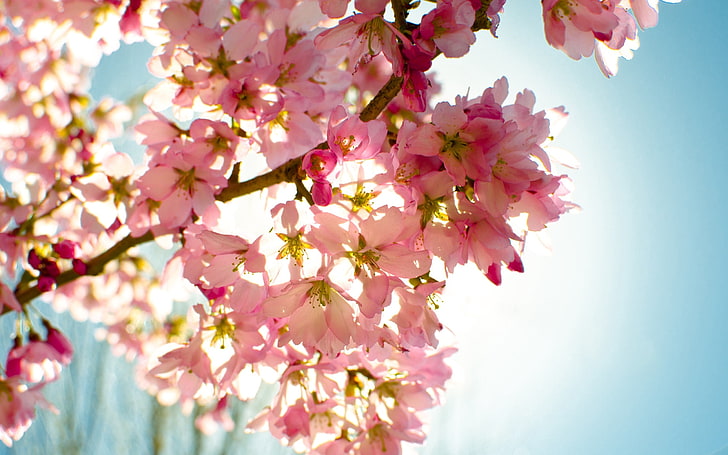Nature’s palette never fails to surprise us, and one of its most captivating marvels is the occurrence of trees with pink and blue leaves. These trees possess a rare and magical quality, offering a dreamlike appearance to any landscape they adorn. Whether it’s the striking shades of pink that evoke a sense of warmth and romance or the cool, calming blues that seem almost otherworldly, trees with such unique foliage stand out as living art. In this guide, we’ll explore the fascinating science behind these colors, showcase some of the most stunning examples, and provide tips on how to grow and care for them in your garden.
Understanding Trees with Pink and Blue Leaves
At first glance, trees with pink and blue leaves seem like something out of a fantasy novel. However, there is a scientific explanation behind their unusual colors. The primary reason for pink and blue leaf pigmentation lies in the presence of anthocyanins—a type of pigment found in many plants. Anthocyanins reflect red, pink, and blue wavelengths of light, giving the leaves their vibrant hues. The intensity of the color can be influenced by factors such as light exposure, soil pH, and temperature.
In many cases, trees with pink and blue leaves are either naturally occurring or cultivated varieties that have been selectively bred for ornamental purposes. While some trees boast these colors year-round, others may exhibit them only during certain seasons, such as spring or autumn, making them even more alluring to gardeners and plant enthusiasts.
Popular Trees with Pink Leaves
For those looking to introduce a touch of warmth and vibrancy to their garden, pink-leaved trees are an excellent choice. Here are some of the most popular species known for their stunning pink foliage:
- Japanese Maple (Acer palmatum): This iconic tree is prized for its delicate, lace-like leaves that turn a brilliant shade of pink or red in the fall. Japanese Maples are slow-growing and perfect for adding a splash of color to smaller gardens or as a focal point in larger landscapes.
- Eastern Redbud (Cercis canadensis): Known for its heart-shaped leaves and striking pink blooms, the Eastern Redbud is a popular choice among gardeners. Some varieties, such as the ‘Forest Pansy,’ also display pink foliage in the spring before turning to green in the summer.
- Forest Pansy Redbud: A standout cultivar of the Eastern Redbud, this tree is loved for its deep pink to purple foliage. In spring, the tree bursts into clusters of vibrant pink flowers, creating a mesmerizing display that lasts for weeks.
Care Tips for Pink-Leaved Trees:
- Light Requirements: Most pink-leaved trees thrive in partial shade, where they can get a mix of direct sunlight and filtered light. This helps maintain the intensity of their pink hues.
- Soil: Well-draining, slightly acidic soil is ideal for these trees.
- Watering: Consistent watering is essential, especially during the tree’s early growth stages.
Popular Trees with Blue Leaves
While pink-leaved trees bring warmth to a garden, blue-leaved trees add a cool, soothing contrast. Here are some notable examples:
- Blue Spruce (Picea pungens): This evergreen tree is renowned for its silvery-blue needles that offer year-round color. The Blue Spruce thrives in cooler climates and is often used as a statement tree in large gardens due to its majestic size and color.
- Eucalyptus (Eucalyptus cinerea): Known for its rounded, powdery-blue leaves, the Eucalyptus tree not only brings an exotic touch to gardens but also offers a delightful aroma. It’s a fast-growing tree that prefers warm, dry climates and can be grown as a shrub or a tall tree depending on pruning.
Care Tips for Blue-Leaved Trees:
- Light Requirements: Blue-leaved trees typically prefer full sun exposure to bring out the vibrancy of their foliage.
- Soil: They thrive in well-drained, neutral to slightly alkaline soil.
- Watering: These trees are often drought-tolerant, making them suitable for low-maintenance gardens.
Combining Pink and Blue Leaf Trees in Your Garden
One of the most visually stunning ways to design a garden is by incorporating both pink and blue-leaved trees. The contrasting colors can create a dynamic landscape that is as peaceful as it is vibrant. For instance, pairing a Japanese Maple with a Blue Spruce can create a visually captivating space that showcases the best of both color spectrums. Here are some design tips to achieve the perfect balance:
- Use as focal points: Place one pink-leaved tree as a centerpiece and surround it with blue-leaved trees to create a layered effect.
- Balance of heights: Ensure there is a mix of tall trees like the Blue Spruce and smaller trees like the Forest Pansy Redbud for visual diversity.
Tips for Growing and Maintaining Trees with Unique Foliage
Both pink and blue-leaved trees require specific care to maintain their color and health. Here are some general tips:
- Soil and Nutrients: Regularly test your soil’s pH to ensure it’s suitable for the specific tree species. Use organic mulch to retain moisture and add nutrients.
- Pruning: Prune regularly to maintain the tree’s shape and remove any dead or damaged branches.
- Pests and Diseases: Watch out for common issues like aphids, fungal infections, or leaf spot diseases, and treat them with organic solutions whenever possible.
Conclusion
Trees with pink and blue leaves bring a sense of wonder and uniqueness to any garden. Whether you prefer the delicate pinks of a Japanese Maple or the striking blues of a Blue Spruce, these trees offer something truly magical for garden enthusiasts. By understanding their care needs and design potential, you can create an enchanting landscape that stands out year-round.
To explore more ways to enhance your garden with unique foliage, visit Grandma Gardens.

